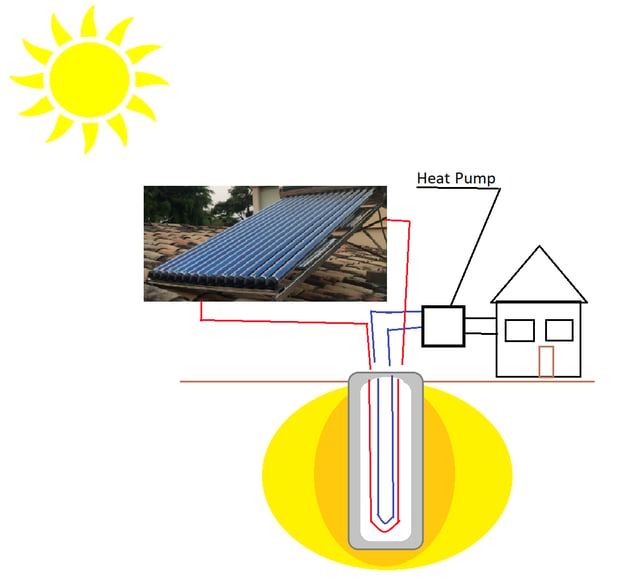Thanks for following the second part of the ground coupled heat pump design. If you haven’t already, now’s a good time to go back and read Part 1. In the first part of this post, we discussed the importance of understanding thermal imbalance in a ground source heat pump system and the longevity impacts associated with an imbalanced system. Despite the issues associated with a thermally imbalanced system, there are ways to address building loads with additional technology that will further enhance the performance of the ground-coupled heat pump system, as well as provide long term performance.
In the most basic sense, the issue of a thermally imbalanced load on a ground heat exchanger is that the building load doesn’t even out every year. In Part 1, we limited the scope of the building loads to include just the envelope’s heating and cooling loads, and as we look at this through the lens of someone designing in northern New England, we can see that the envelope loads don’t balance out. But let us consider for a moment what other loads buildings contain. Often there are server rooms, which require constant cooling, kitchens (frequently with large cooling loads), and other large equipment that often has substantial sensible cooling requirements.
In addition to other loads on the cooling system, we should consider where else we can absorb additional heat from to help achieve balance. One source is using the heat pump system for active heat recovery of the exhaust air (see Figure 1). Another source of heat that lends itself very neatly to ground source heat pumps is solar thermal, in the form of evacuated tubes, or flat plate style heat exchangers. Utilizing solar thermal on a project yields multiple benefits.
Figure 1. Exhaust Air Active Heat Recovery
Solar thermal collectors are often used to collect solar energy and use it for preheating or heating of the domestic hot water system. Collectors used in this way have an obvious and distinct disadvantage: if the sun isn’t providing enough energy to warm the water in the solar collector, it won’t provide any meaningful heat to the domestic water system. However, the use of solar thermal collectors can be utilized in two ways when installed in a building with ground source heat pumps. They can be used for pre-heating the domestic water, and they can also serve as a heat source to help overcome the effects of thermal imbalance. Using them to provide heat injection to the ground source heat exchanger allows them to act as a battery re-charger for the ground heat exchanger.
Figure 2. Double U-Tube Ground Source Heat Exchanger Configuration

Beyond utilizing other sources of heat to help the ground source heat exchanger recover from the chilly northeastern winters, there are newly developed products and designs that can help optimize the ground source heat exchanger. In the past, vertical borefields generally consisted of U-Tube piping with thermally enhanced grout. Now, there are many different options, all that will help to reduce initial installation costs, while offering the same or better performance. Some of the options for vertical bores are shown in Figure 3 through Figure 5.
Figure 3. Example of a Helical Bore Heat Exchanger

Figure 4. Example of a Piping Bundle to be Installed in a Vertical Bore
 Source: https://www.prweb.com/releases/2013/2/prweb10468012.htm
Source: https://www.prweb.com/releases/2013/2/prweb10468012.htm
Figure 5. Example of Coaxial Vertical Bore Heat Exchanger

One study[1] found that bundle-type vertical bores resulted in total bore length reductions between about 38-62%, while double U-Tube configurations resulted in total bore length reduction between about 28-43%. When considering optimizing a ground source heat pump system, consider the cost impacts of deeper, more numerous wells and how to increase the annual capacity of the ground source heat pump system using other sources of heat. Each of these options can help provide a ground source heat pump system to a client that will deliver with lower installation costs up front and long term energy efficient performance.


